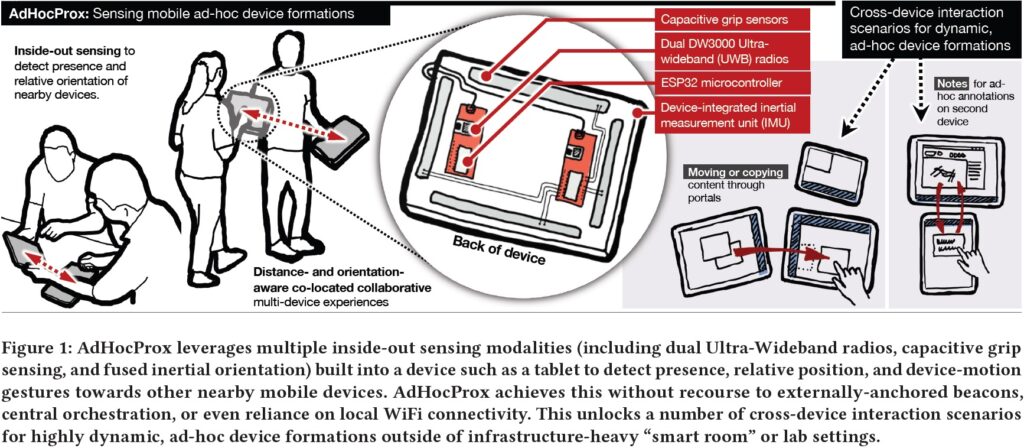AdHocProx: Sensing Mobile, Ad-Hoc Collaborative Device Formations using Dual Ultra-Wideband Radios
- Richard Li ,
- Teddy Seyed ,
- Nicolai Marquardt ,
- Eyal Ofek ,
- Steve Hodges ,
- Mike Sinclair ,
- Hugo Romat ,
- Michel Pahud ,
- Jatin Sharma ,
- William A. S. Buxton ,
- Ken Hinckley ,
- Nathalie Henry Riche
CHI '23: Proceedings of the 2023 CHI Conference on Human Factors in Computing Systems |
Published by ACM
We present AdHocProx, a system that uses device-relative, inside-out sensing to augment co-located collaboration across multiple devices, without recourse to externally-anchored beacons – or even reliance on WiFi connectivity.
AdHocProx achives this via sensors including dual ultra-wideband (UWB) radios for sensing distance and angle to other devices in dynamic, ad-hoc arrangements; plus capacitive grip to determine where the user’s hands hold the device, and to partially correct for the resulting UWB signal attenuation. All spatial sensing and communication takes place via the side-channel capability of the UWB radios, suitable for small-group collaboration across up to four devices (eight UWB radios).
Together, these sensors detect proximity and natural, socially meaningful device movements to enable contextual interaction techniques. We find that AdHocProx can obtain 95% accuracy recognizing various ad-hoc device arrangements in an offline evaluation, with participants particularly appreciative of interaction techniques that automatically leverage proximity-awareness and relative orientation amongst multiple devices.

AdHocProx: Sensing Mobile, Ad-Hoc Collaborative Device Formations using Dual Ultra-Wideband Radios
This CHI 2023 video demonstrates AdHocProx, a system that uses device-relative, inside-out sensing to augment co-located collaboration across multiple devices, without recourse to externally-anchored beacons – or even reliance on WiFi connectivity. AdHocProx achieves this via sensors including dual ultra-wideband (UWB) radios for sensing distance and angle to other devices in dynamic, ad-hoc arrangements; plus capacitive grip to determine where the user’s hands hold the device, and to partially correct for the resulting UWB signal attenuation. All spatial sensing and communication takes place via the side-channel capability of the UWB radios, suitable for small-group collaboration across up to four devices (eight UWB radios). Together, these sensors detect proximity and natural, socially meaningful device movements to enable contextual interaction techniques. We find that AdHocProx can obtain…
